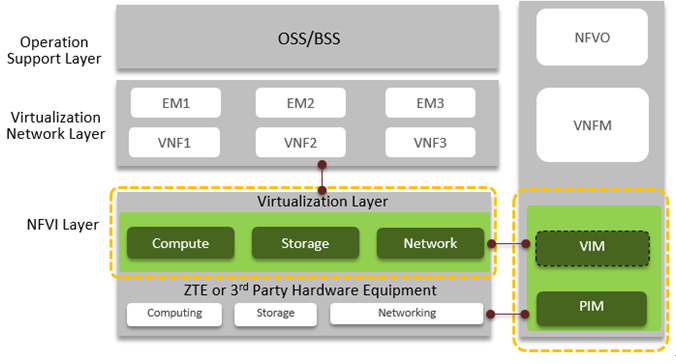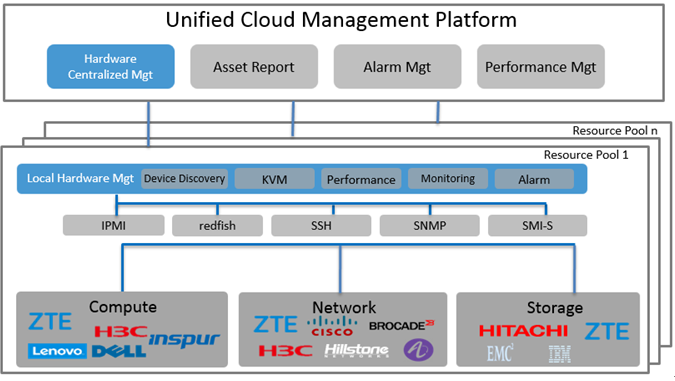PIM comes into being, for Operator’s NFV aims to realize decoupling of hardware and software
5G is the product of the mobile Internet era. Traditional physical equipment cannot meet the requirements of various Internet applications according to the service configuration network. To cope with the challenges brought by the Internet era to the telecom market, operators use the ETSI NFV specification, together with cloud computing and virtualization technologies, to decouple software from hardware of telecom NEs and quickly realize the development and commissioning of network functions and various applications.
NFV (Network Function Virtualization), whose basic concept is based on standard X86 and other hardware platforms such as architecture servers, general-purpose storage and switches, adopts the virtualization technology to carry various network functions on virtualized hardware resources and replace traditional communication devices by using virtual network elements to realize NFV. ZTE launches the ZTE NFVI solution together with the carrier's NFV three-layer decoupling:

Figure 1 ZTE NFVI Solution
The technical architecture of NFV is divided into three layers:
- Infrastructure layer: It is NFVI (NFV Infrastructure), which is based on universal computing, storage, and network resources to provide VNF bearer capability for the upper layers.
- PIM (Physical Infrastructure Manager): Is responsible for centralized management of hardware devices in the resource pool, and provides configuration management, fault management, and performance monitoring.
- VIM (Virtualized Infrastructure Manager): Provides computing, storage, and network virtualization capabilities.
- Virtualization network layer: Corresponds to each telecom service network element.
- Operation support layer: Is operator’s operation and maintenance support and business support system.
It is clear that NFVI, which is a general term for the underlying hardware and virtualization resources, is an important basis for NFV deployment. PIM provides centralized management of physical devices in the NFVI layer to help manage common hardware.
Challenges faced by hardware management
- Diversification of hardware manufacturers
General hardware is divided into computing, storage, and network physical devices (the following device manufacturers are arranged in alphabetical order). Mainstream server vendors include DELL, HP, H3C, Inspur, and ZTE. Mainstream magnetic array vendors include EMC, IBM, and ZTE. Mainstream switch vendors include CISCO, H3C, and ZTE.
The diversification of hardware vendors means that alarm events and performance indicators cannot be unified. The adaptation layer needs to be added to hardware management to meet the generalization processing of hardware vendors.
- Diversification of hardware protocols
Hardware management and hardware devices generally communicate through out-of-band management protocols. Different device types have different common standards. For example, servers are generally managed through interfaces such as IPMI, SNMP, and redfish. Switches are generally managed through SNMP interfaces and protocols. Disk arrays are generally managed through interfaces/protocols such as SNMP and SMI-S.
As a centralized device management platform, hardware management needs to support common protocols for various types of devices, and shield the implementation differences between different vendors at the same time.
- It is difficult to confirm the scope of hardware failure, so it is difficult to track the fault.
The NFV technology architecture is divided into NFVI layer, virtual network layer, and operation support layer. The NFVI layer is further divided into PIM and VIM. The NFV hierarchy brings architectural decoupling so that the upper layer may not be able to obtain enough information to track the fault and locate the specific physical device and the range of faults of physical devices cannot be analyzed accurately.
When physical devices are managed in centralized mode, hardware management, as the underlying platform, needs to open the standard API to the north to provide physical equipment data for the upper management system. The upper management system analyzes the root cause and impact scope.
PIM assists effective management of universal hardware
TECS (Tulip Elastic Cloud System) is a comprehensive cloud computing solution that is based on OpenStack open source platform and integrated with the NFV architecture. TECS OpenStack provides virtual machines and bare metal services; TECS OpenPalette also provides container cloud services.
PIM, as a component of TCS OpenStack, provides local management of IaaS resource pool hardware. Meanwhile, it provides PIM Mgt as a unified cloud management platform component in locations such as region to support unified management of multiple resource pool devices:

Figure 2 PIM Assists Unified Management of Universal Hardware
- Supporting the unified management of multiple vendors and multiple types of equipment
Collaboration between the upper-layer unified cloud management platform and the lower-layer PIM to provide unified device management: PIM provides local management of common hardware devices such as servers, storage, and networks in the resource pool, and the unified cloud management platform provides unified management of multiple resource pool devices.
Supporting multiple protocols to access and manage hardware devices: Servers support IPMI, SNMP, and redfish (The redfish is regarded as an alternative to IPMI protocol, and PIM is supported synchronously according to the requirements of operators such as medium migration and hardware vendors' support) and other protocols. Switches support access and management of protocols such as SNMP. Disk arrays support access and management of protocols such as SNMP and SMI-S.
Supporting unified operation and maintenance of the hardware in the resource pool: Devices of different hardware types are generalized to shield the difference of devices. PIM provides the unified performance monitoring model, and provides unified hardware configuration and operation management, including general operations such as power-on, power-off, and reset of the server.
- Collaboration with deployment tools to support the rapid commissioning of OS
PIM, which is regarded as a component of TECS OpenStack, not only provides out-of-band management of hardware, but also collaborates with deployment tools to quickly deploy physical servers as compute nodes.
- Opening the APIcapability to the north
PIM (Hardware Management) supports the capability to open the API to the north and connect to NFVO through interfaces such as RESTful, and provides hardware resource information for NFVO and other devices so that they can complete the root cause analysis and fault impact range analysis.
The PIM Mgt of the unified cloud management platform opens the asset data reporting interface to the north to provide hardware asset data for the upper OSS and other systems so that they can audit assets.
Hardware management introduction scenario
In the era of mobile Internet, some traditional services will continue to run on physical devices. At the same time, container, which is regarded as a virtualization technology, can, just like virtual machines, provide virtualization resources and management capabilities for upper-layer applications to support network function virtualization. Hardware management provides the following multiple deployment scenarios together with several business application scenarios, including virtual machine, container, and physical server:
- Being responsible for ZTE’s physical devices as the hardware management in independent product form
For the scenario of some traditional services, they will continue to run on the physical device. The hardware management, together with the ZTE universal hardware Uniview product, is responsible for managing the ZTE’s servers.
- Managing the hardware in the IaaS resource pool as the cloud platform component of TECS OpenStack
For the IaaS resource pool, PIM provides the operation and maintenance capabilities such as physical device alarm, performance, and status monitoring. It can also be used as a component of the TECS OpenStack Adapter to manage resource pool hardware such as vCenter.
- Managing the hardware of the container resource pool as the container cloud component of TECS OpenPalette
For the TECS OpenPalette container cloud, PIM provides the operation and maintenance capabilities such as physical device alarm, performance, and status monitoring. It also collaborates with the deployment components of TECS OpenPalette to support deployment and capacity expansion of nodes in the container resource pool.
Hardware management transforms the original physically-dispersed operation and maintenance mode into a centralized management operation and maintenance mode, improving the operation and maintenance efficiency. It is a huge change brought about by the mobile Internet era.
ZTE supports AI with full-stack IT offering
5GC Green Engine Solution to Enable Green Internet of Everything in the Dual-Carbon Era
5GC Private Network 2.0 Empowerment and Efficiency Improvement Boosts High-Quality Development of the Industry
5G Empowers Intelligent Mining for High-quality Development of Shaanxi Coal Caojiatan Mining
ZTE and China Mobile embrace digitalization for biodiversity conservation in Panda Reserve
Three Aspects Contribute to ZTE’s Remarkable Breakthroughs in Advanced G4X Server
How 5G Private Networks Are Poised to Transform Enterprises Worldwide: All Scenario Private 5G Helps Operators to Realize Private 5G as a Service
ZTE’s commitment to servers generates robust growth of up to 60 times in past 8 years
ZTE eyes top 5 global server market share
Full-Scenario One-Stop 5G Private Network for Vertical Industries

